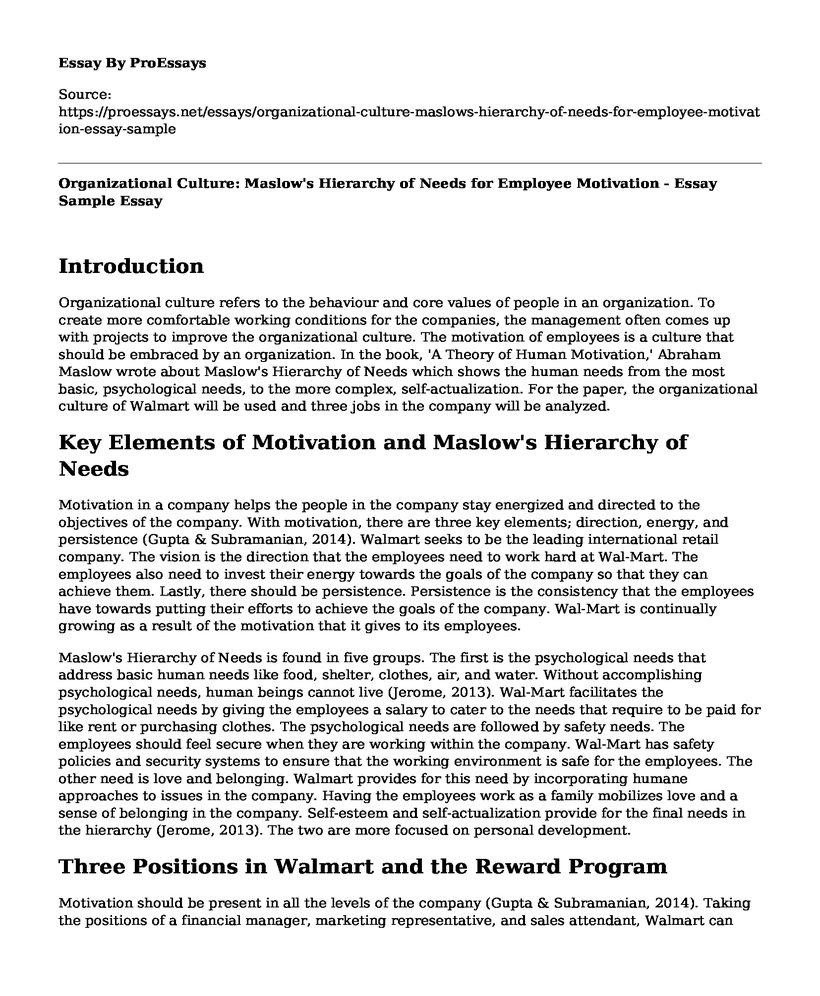Introduction
Organizational culture refers to the behaviour and core values of people in an organization. To create more comfortable working conditions for the companies, the management often comes up with projects to improve the organizational culture. The motivation of employees is a culture that should be embraced by an organization. In the book, 'A Theory of Human Motivation,' Abraham Maslow wrote about Maslow's Hierarchy of Needs which shows the human needs from the most basic, psychological needs, to the more complex, self-actualization. For the paper, the organizational culture of Walmart will be used and three jobs in the company will be analyzed.
Key Elements of Motivation and Maslow's Hierarchy of Needs
Motivation in a company helps the people in the company stay energized and directed to the objectives of the company. With motivation, there are three key elements; direction, energy, and persistence (Gupta & Subramanian, 2014). Walmart seeks to be the leading international retail company. The vision is the direction that the employees need to work hard at Wal-Mart. The employees also need to invest their energy towards the goals of the company so that they can achieve them. Lastly, there should be persistence. Persistence is the consistency that the employees have towards putting their efforts to achieve the goals of the company. Wal-Mart is continually growing as a result of the motivation that it gives to its employees.
Maslow's Hierarchy of Needs is found in five groups. The first is the psychological needs that address basic human needs like food, shelter, clothes, air, and water. Without accomplishing psychological needs, human beings cannot live (Jerome, 2013). Wal-Mart facilitates the psychological needs by giving the employees a salary to cater to the needs that require to be paid for like rent or purchasing clothes. The psychological needs are followed by safety needs. The employees should feel secure when they are working within the company. Wal-Mart has safety policies and security systems to ensure that the working environment is safe for the employees. The other need is love and belonging. Walmart provides for this need by incorporating humane approaches to issues in the company. Having the employees work as a family mobilizes love and a sense of belonging in the company. Self-esteem and self-actualization provide for the final needs in the hierarchy (Jerome, 2013). The two are more focused on personal development.
Three Positions in Walmart and the Reward Program
Motivation should be present in all the levels of the company (Gupta & Subramanian, 2014). Taking the positions of a financial manager, marketing representative, and sales attendant, Walmart can employ motivation for their employees and have them give their best towards achieving the goals of the company. The financial manager at Walmart can be motivated by having modern information systems that can capture cash flow by the second they occur. The marketing representative can be motivated by having a team of experts in their team, enough resources as well as having platforms to showcase promotional messages on behalf of the company. The sales attendant can be motivated when they have convenient space for working.
Every employee in the company can also be motivated by receiving financial compensation that equals the efforts that they put in the company. A reward program that will help the employees work well and endeavor to stay in Walmart should consist of considerate reimbursements, allowances for the employees, free training programs for the employees to grow their skills and paid vacations for the employees. The organizational culture of a company should motivate the employees of the company to put more persistent efforts towards achieving the goals of the company (Enginoglu & Arikan, 2016).
References
Enginoglu, D. & Arikan, C. L. (2016) Effects of Organizational Culture on Business Ethics: A Conceptual Study. International Journal of Research in Social Sciences 2013-2016 IJRSS & K.A.J. http://www.ijsk.org/wp-content/uploads/2015/12/6-ORGANIZATIONAL-CULTURE.pdf
Gupta, B., & Subramanian, J. (2014). Factors affecting Motivation among Employees in Consultancy Companies. International Journal of Engineering Science Invention, 3(11), 59-66. http://www.academia.edu/download/36422156/H0311059066.pdf
Jerome, N. (2013). Application of Maslow's Hierarchy of Need Theory; Impacts and Implications on Organizational Culture, Human Resource, and Employee's Performance. International Journal of Business and Management Invention, 2(3), 39-45. http://www.academia.edu/download/46837791/G233945.pdf
Cite this page
Organizational Culture: Maslow's Hierarchy of Needs for Employee Motivation - Essay Sample. (2023, Apr 08). Retrieved from https://proessays.net/essays/organizational-culture-maslows-hierarchy-of-needs-for-employee-motivation-essay-sample
If you are the original author of this essay and no longer wish to have it published on the ProEssays website, please click below to request its removal:
- Management and Leadership of Virtual Teams Essay
- Multicultural Counseling Essay Example
- Essay Sample on Leadership Matrix
- How ADD Affects People's Ability to Write? Essay Example
- Paper Example on One Week of Silence: A Life-Changing Mental Therapy
- Gender Pay Gap: Unfair Policies & Poor Protection - Essay Sample
- Free Report Example on Aphasia: Understanding the Neurolinguistic Disorder







